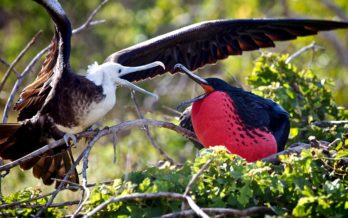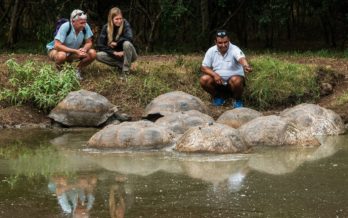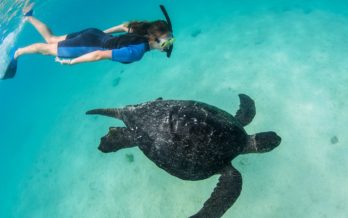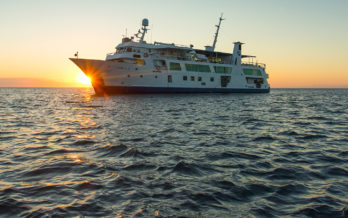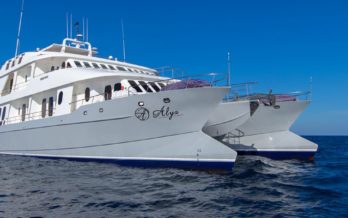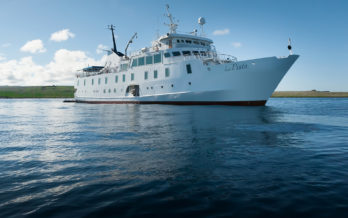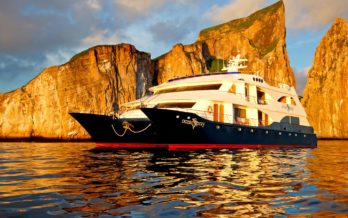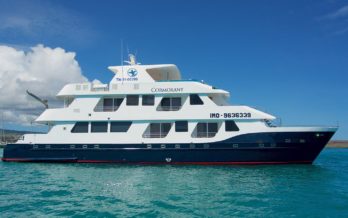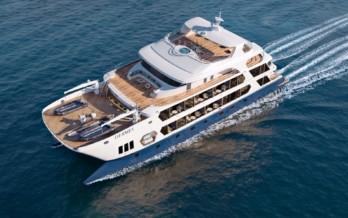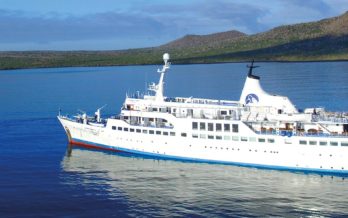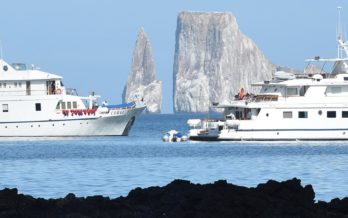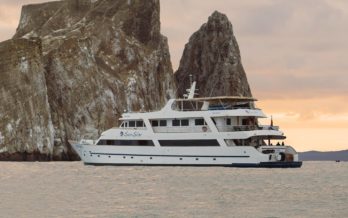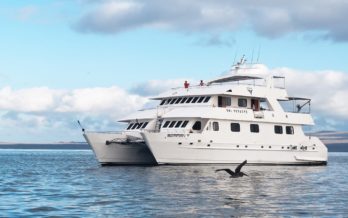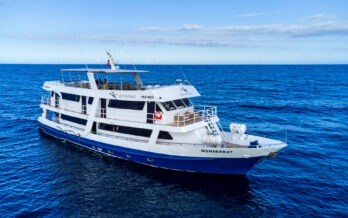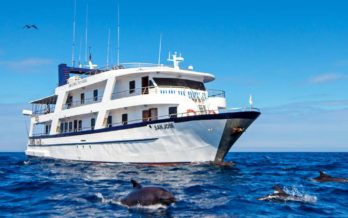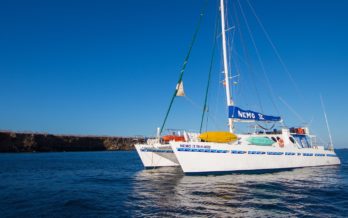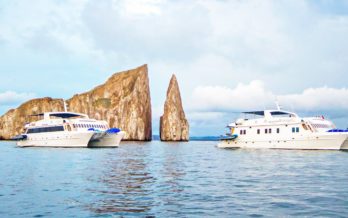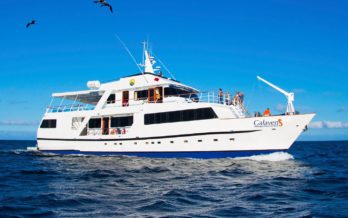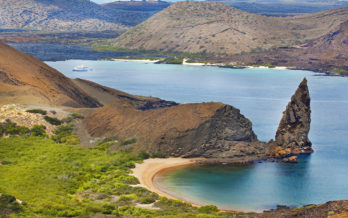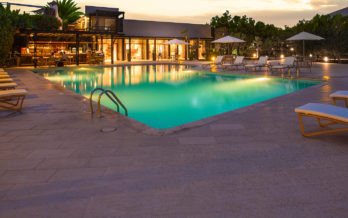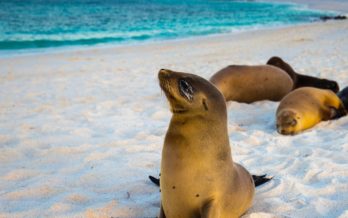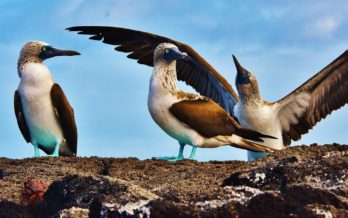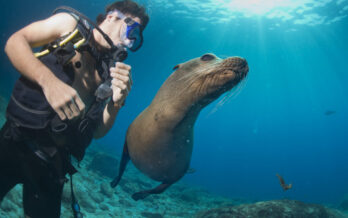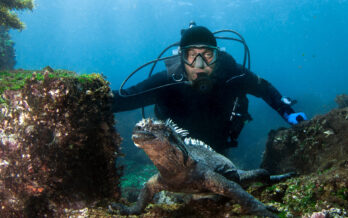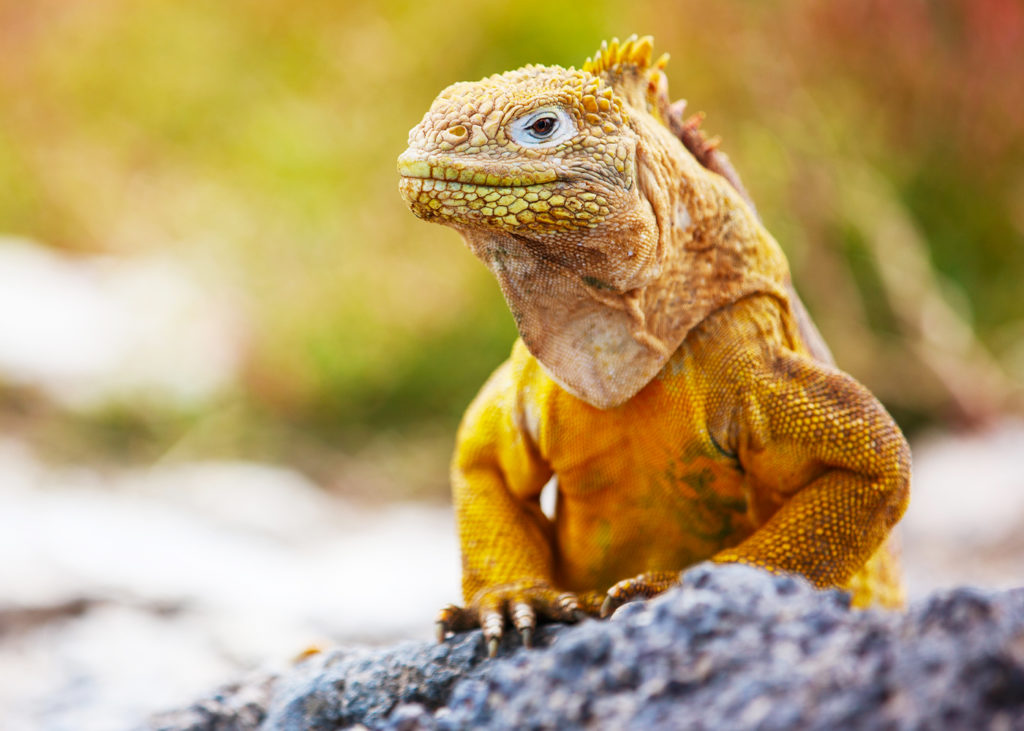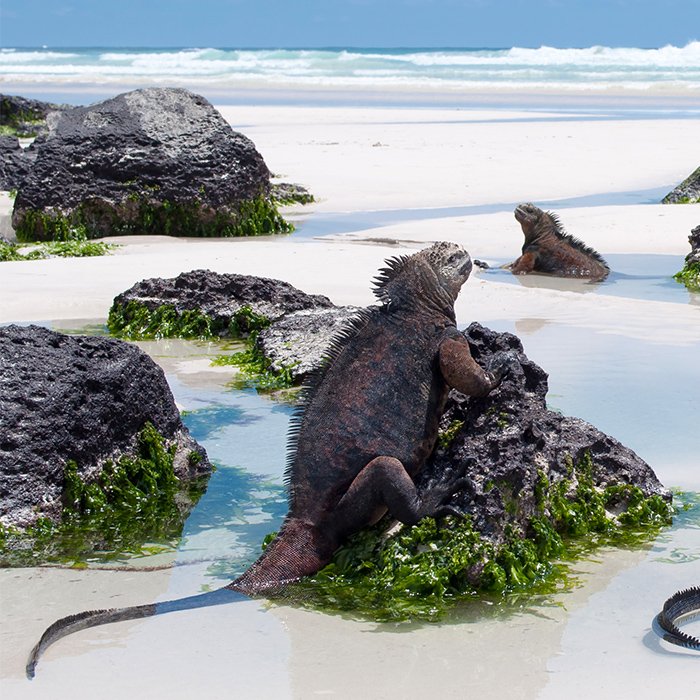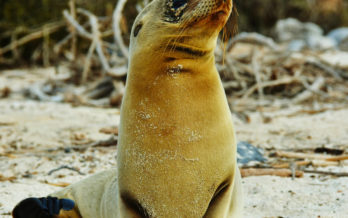Galapagos Islands Tours
Go island-hopping with our Galapagos island tours and cruises. Visit Santa Cruz, South Plaza and see wildlife and landscapes found nowhere else. Talk to our travel experts today.
Experience Galapagos Islands
Located some 1000 km off the Pacific Coast of Ecuador, the Galapagos Islands are made up of 13 main islands, 6 smaller islands and more than 40 tiny islets. Discovered in 1535, this archipelago inspired Charles Darwin’s theory of “Evolution of the Species” as the animals and plants have adapted to the geography of each island because of their isolation from the mainland. Due to the volcanic origin of their location on the equator, they are constantly changing. Many volcanoes found here are still active.
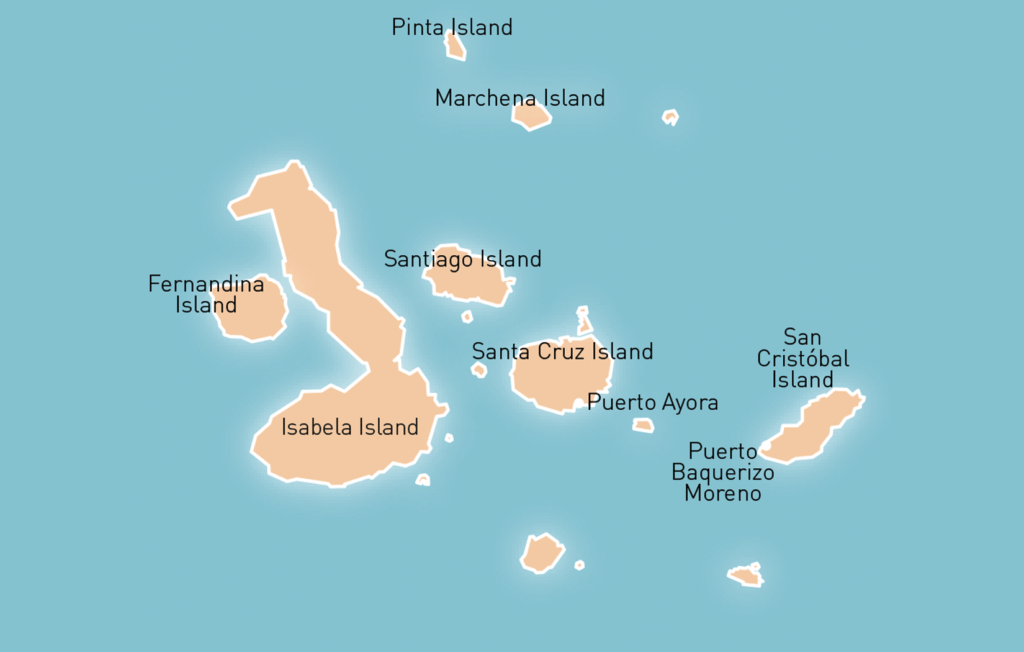
Guide to the Galapagos Islands
Santa Cruz
Santa Cruz is the second largest island you’ll see on a Galapagos Island Tour. The small town of Puerto Ayora is the economic Turtle crossing sign on Santa Cruz Island in the Galapagos Islands center of the archipelago, with the largest population of the 4 inhabited islands, approximately 8,000. Tourism, fishing, boat building and commerce are the major productive activities. Santa Cruz is also the only island where six different vegetation zones can be seen: Coastal, Arid, Transition, Scalesia, Miconia and Pampa zones.
Santa Cruz is home to the Charles Darwin Station, where visitors can observe tortoise research and breeding programs. Scientists, park rangers, and park managers among others conduct the conservation of the islands and make huge efforts to preserve this UNESCO World Heritage Site. Don’t forget to say hello to the tortoise Lonesome George – the last of his species.
A trip to the lush greenery of the Santa Cruz highlands offers a welcome contrast with the arid scenery of the smaller, lower islands. You will get a chance to see enormous pit craters, lava tunnels and giant tortoises roaming freely.
South Plaza
This small steep-cliffed island was formed by uplifted lava and is covered by opuntia cactuses – a tree like cactus endemic to the area. It is also home to one of the largest sea lion colonies. Be careful not to get too close! Each colony is lead by a bull and consists of 15-20 females. After about 3 months of playing king, these bulls retire to the “Bachelors” colony and rest. These colonies consist also of very young bulls that are still too young to hold a territory or be a threat to the reining bull.
Also, on South Plaza, you will find the lazy but colorful yellow and red land iguana. This animal likes this island because of its richness in the opuntia cactus, which is an iguana delicacy. There are about 700 iguanas on the island and this species seems to be one of the smallest iguana species.
Santa Fe
Unlike most of the islands in the Galapagos that were formed by volcanic eruptions, Santa Fe was formed by an uplift caused by tectonic activity. This means that the island does not have the typical cone shape. Santa Fe has one of the most beautiful coves of all the visitor sites in the region – a turquoise lagoon protected by a peninsula of rocks and small islands that extends from the shore.
Hike along the coastline and discover colorful flora and fauna. The well-known land iguanas here can grow over five feet long. The Sanfa Fe species of iguana are more bright yellow and have uncommonly large spikes on their spine. In true style the opuntia cactus, a favorite food of the land iguana, has responded by growing tall and woody – up to 33 feet high and are the largest of their kind in Galapagos. Manta rays and sea turtles flit by as dark shadows against the sandy bottom of Santa Fe’s beautiful anchorage.
After a long hike, relax with a swim in the calm waters of the beautiful bay, or snorkel along in the company of sea lions at the base of the rocks.
Española
This is southernmost island and because of its remote location, it has a high proportion of endemic fauna. For example it is the breeding site of nearly all of the world’s 12,000 pairs of waved albatrosses. These large birds perform one of the most spectacular rituals of the animal world. Watching them take off is an unforgettable moment. Espanola teems with mockingbirds, blue-footed and masked boobies, Darwin finches, Galapagos doves, hawks, red and green marine iguanas, and sea lions. Watch Blue-footed boobies with Adventure Life.
Gardener Bay offers great opportunities for enjoying some beach time in the Galapagos. Here the mockingbirds will be the center of your attention as they keep you company on top of your hat or investigating your belongings.
Punta Suarez is quite an amazing site and one of the most attractive in the Galapagos, because of the quantity and variety of wildlife. The trail along the island will take you past sea lions surfing the breaking waves, iguanas basking in the warm sun and boobies nesting right in your path. The trail continues towards the cliffs and the blowhole, which is a fissure in the lava where water spurts high in the air like a geyser.
Floreana
This is one of the islands that has the most interesting human history. It was one of the earliest islands to be inhabited. In 1793 a post office barrel was erected on Floreana to facilitate delivery to the United States and Europe. Today, this area of the island is of course called Post Office Bay. You will also find the remains of a Norwegian commercial fish drying and canning operation in this area and a lava tube that extends to the sea.
At Punta Cormorant more than 50 volcanic cones rise in an 80-mile area. Pink flamingos, clear water and interesting coral growths make this a perfect spot for snorkelling.
The Devil’s Crown is a volcanic crater near Floreana that has been eroded by the waves. Here snorkelers are immersed in a world of color and movement filled with schools of fish that move as one: king angelfish, yellowtail surgeonfish, and needlefish. There are also parrotfish, Moorish idols, and damselfish, sea cucumbers, sea stars, sea urchins, sleeping sharks, turtles, rays and many more, making this one of the best snorkelling sites in the Galapagos.
Rabida
One of the special features of Rabida is the remarkable red color, which is a result go the high percentage of oxidized iron in the composition of the lava.
Rábida is a bird-watchers delight. Some of the rarest species are in abundance, such as 9 varieties of finches, large billed flycatchers, Galapagos hawks and brown pelicans. The dark red sand beaches and a horde of snoring sea lions make for spectacular snorkelling. Also, the island is home to the skinny legged Flamingo, which can be seen in a salt-water lagoon near the beach.
From the observatory on the southeastern part of the island, you can appreciate the red color of the beach and the rocks surrounding it.
Santiago
This island was once home to a salt mining enterprise and its remains can still be seen if you walk from the black beach where you land, and continue along the coast. You will also see many inter-tidal pools that are homes to a large variety of invertebrate organisms.
Fur seals were thought to have gone extinct by 1905, but have since made a dramatic comeback. Santiago provides habitat for many of the 30-40,000 fur seals that call the Galapagos home. If you plan on taking pictures of the fur seals, Puerto Egas is an excellent spot. At dawn or sunset, the light is perfect for great photography. There are also plenty of sea lions on the black beach of Puerto Egas.
Take a moment after exploring the island and swim with the playful sea lions off the coast of two small coral-lined beaches.
Bartolome
This island is home of the famous Pinnacle Rock, which is the most representative landmark of the Bartolome Island. Climbing to the top of this popular landmark rewards visitors with panoramic views of varied lava formations, volcanic peaks and moon-like landscape. Walking on the rocks at the base of Pinnacle Rock are Galapagos Penguins. This is the smallest species of penguins and the only species found north of the Equator.
At the beach on the southern side, if you come in the right season, you can see nesting sea turtles resting in the sand or wading in the shallow water. You might also spot a white-tipped reef shark patrolling the close to the shore. This island was formed by volcanic activity and since it is relatively young, the colonization is very fragile. Therefore it is important to be careful and stay as much as possible on the trails.
North Seymour
North Seymour was like a few other islands, uplifted by underground seismic activity. This tiny island is packed with countless sea lions and it’s one of the most popular breeding grounds for sea birds. A very large colony of frigate birds nest here, and it’s almost guaranteed to see a few males proudly displaying their red pouches to impress a mate.
It is also one of the best places to see blue-footed boobies and magnificent frigate birds. If you are lucky, you might catch a glimpse of their courtship dance, which is quite peculiar and amusing. Also, while visiting this island, you might very well witness a great show of acrobatic flight, namely a frigate bird robbing a booby, a gull or even another frigate bird of their food.
Genovesa
Genovesa is a sensation of unspoiled nature and is considered a bird-watchers paradise. The volcanic sea cliffs around Darwin Bay offer prime breeding places for frigate birds, swallow-tailed gulls, storm petrels, tropic birds and red-footed boobies. If you climb up the Prince Phillip’s Steps onto the plateau, you will find that no matter where you look there will be a bird.
Genovesa offers good snorkelling opportunities at the beach or alongside the cliffs on the shoreline. Because of the richness of nutrients in the bay, you never know what you might encounter.
Black Turtle Cove
This lovely cove includes a red mangrove lagoon on Santa Cruz Island. There are no landing sites so most visitors travel via panga or kayak. The calm lagoon provides a nursery for many sharks and rays. Sightings of white-tipped reef sharks, hammerheads, golden rays, spotted eagle rays, and black-tipped reef sharks are relatively common. Pelicans and herons also frequent the area and sea turtles can sometimes be seen mating in the mangrove-lined waters.
Chinese Hat
The Chinese Hat (Sombrero Chino) is a miniature volcano that is shaped like a Chinese hat (hence its amusing name). Watch colourful Sally Lightfoot crabs in the Galapagos Islands with Adventure Life Reached by a shallow channel, where the yachts need to navigate close to the coast of Santiago, this island is a Galapagos travel highlight.
As you land on the Chinese Hat, you will find that little has changed since its first discovery many centuries ago. Today one will still be amazed by the lava formations, spatter cones, lava tubes and the lava Cactuses struggling to grow in the scarce soil. You will be greeted by colorful Sally Lightfoot Crabs fleeing from the crushing waves on the shore, and flabbergasted by underwater schools of fish, Manta Rays and sharks.
San Cristobal
San Cristobal is the Eastern most island in the Galapagos, located in the southeast corner. It is home of the oldest settlement in the islands, Puerto Baquerizo Moreno, which is also the capital of the province Galapagos. Here, the Interpretation Center was recently opened by the Galapagos National Park. This is an amazing educational and informational contribution to the island community and travellers.
San Cristobal claims some of the most spectacular landscape. The cloudforest in the highlands is perfect habitat for giant tortoises.
Frigatebird Hill is a short distance walk from the Interpretation Center. Here you can see Magnificent Frigatebirds and Great Frigatebirds in the same colony, which offers great opportunities for studying and learning to distinguish the two species.
El Junco Lagoon is one of the few permanent fresh water lakes in the Galapagos. It is located at an altitude of 2,300 ft/700m, about 45 minutes with bus from Puerto Baquerizo Moreno. On your way to El Junco Lagoon you will pass different vegetation zones, before you reach the panoramic site, where the bird watching is exceptional as well as the view.
About 1 hour travel across a small channel, will take you to Isla Lobos. The name means Sea Lion Island, which is certainly appropriate since many sea lions frolic, leap and make their homes here. This island is also a great place for snorkelling opportunities as well as to view blue-footed boobies.
Kicker Rock (or Leon Dormido) is an enormous rock, located off the north west coast of San Cristobal, that rises 500 feet straight up from the ocean. It has the shape of a sleeping lion, and a split with towering verticals on either side, forming a narrow channel.
Isabela
Isabela is the largest and one of the most volcanically active islands in t
he Galapagos. The island has five active volcanoes and it is well known for the 5 subspecies of giant tortoise that live in the cloudforests of Isabela. These forests, as well as the massive volcanoes silhouetting against the sky, offers a remarkable contrast to the lower islands of the eastern archipelago. West of Isabela, you might very well catch a glimpse of humpback whales breaching completely out of the water, as well as playful dolphins. Stingrays, small sharks, and t
urtles are found in mangrove lagoons on Isabela.
Tagus Cove is one of the landing spots on the island and was historically used as an anchoring site for pirates and whalers. The trail that goes from Tagus Cove will take you through many different vegetation zones and offers spectacular views of Darwin Lake, which is a saltwater crater lake. Once you get to the top of the trail, you will be able to see Darwin Volcano as well as Wolf Volcano, which is the highest point of the islands.
Luxury Galapagos Cruises
First Class Cruises
Standard Class Cruises
Land Based Adventure
Get in touch today,
we’d love to talk to you.
Request a Brochure
Get our latest brochures and start planning your next holidays.
